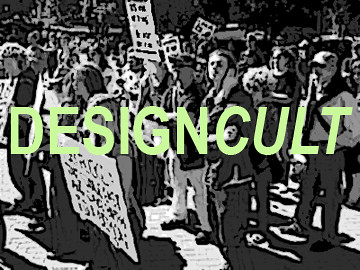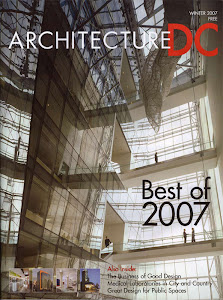

 Seamless integration. In a project this is something most aspire to. But there are certainly times that being too well incorporated into the surroundings can be a detriment. Take for instance the case of the mid-block office building. It is all too often the case that such buildings are so well integrated into the urban fabric that they are easily missed...passed by in our hurried progress. This is even compounded when the architecture is, well, nondescript, as was certainly the case at 1110 Vermont prior to a recent renovation. I admit that I myself had walked down this stretch of Vermont Avenue many times on my way to and from the McPherson Square metro when I first started working in the city, taking note of little more than the traffic in and out of the building's parking garage. It's a difficult program. How do you get people to take notice of an existing, blasé building?
Seamless integration. In a project this is something most aspire to. But there are certainly times that being too well incorporated into the surroundings can be a detriment. Take for instance the case of the mid-block office building. It is all too often the case that such buildings are so well integrated into the urban fabric that they are easily missed...passed by in our hurried progress. This is even compounded when the architecture is, well, nondescript, as was certainly the case at 1110 Vermont prior to a recent renovation. I admit that I myself had walked down this stretch of Vermont Avenue many times on my way to and from the McPherson Square metro when I first started working in the city, taking note of little more than the traffic in and out of the building's parking garage. It's a difficult program. How do you get people to take notice of an existing, blasé building?
Taking up the challenge was Studios Architecture, who, in addition to making several minimal, yet thoughtful gestures on the building facade, further recognized the need to create a street presence. To that end, Studios enlisted MY Studio, a multidisciplinary art and design studio, to create an interactive audio/video installation. The result is a truly eye-catching, if not mesmerizing, assembly of high-tech displays and a field of sound resonating rods. Bearing the title LowResHiFi, the installation is broken into what the designer/artist refers to as the Sound Grove, a field of tall, stainless steel poles with lighted discs which emit sounds when touched by passersby, and the Light Stream, which are composed of a series of screens with 'pixel' lights which display the building's address and other information, and in certain cases project the image of the pedestrian traffic both in- and outside the building, thanks to the aid of strategically located cameras. True this interactive installation makes quite an impact on the otherwise unremarkable streetscape and helps to create a street presence for the building. But more than that it represents the dynamic nature of the city, creating unique urban moments through the ever changing displays, constantly recreating itself in response to its environment. The life of the city is revealed in impromptu street performances created by a passing crowd.
There is a commendable level of collaboration visible in the thoughtful incorporation of the installation within the architecture and interiors. This is the seamless integration that is so pleasant in a well-tailored space. The lobby boasts warm woods and stainless steel elements which combine beautifully with the installation, creating a modern, high-tech, refined aesthetic. The reception desk with its fiber optic lit glass apron does just enough to be visually interesting without competing with the two interior interactive displays. The installation, in turn, is placed in such a way that it becomes part of the architecture.
A thoughtful economy of gestures is also present on the renovated facade, where, rather than choosing to fully reface the building facade, which seems to be the prevailing response for aging downtown buildings (standby for a future post on this craze), the architects made strategic adaptations to the facade. Responding to the existing grid of windows, Studios quilted bands of new glass curtainwall, asymmetrically locating a vertical band to one side of the facade to mark the building 's entry, and placing a second horizontal band along the full length of the facade at the top floor. This upper band is thickened at the south end of the building, and topped with a brise soleil, which acts to restore balance to the facade. A continuous awning and storefront help to define the newly enlivened pedestrian zone.
The incorporation of public art into the streetscapes of DC is something that truly makes our urban experiences unique. It adds further dimension to our urban environments and helps to distinguish one block from another. How much more inspiring and memorable K Street Canyon might be with thoughtful insertions such as this. At a time when many downtown building owners seem to be taking steps to freshen and enliven the look of their buildings and attract new tenants, we hope that some might take note of this fine example and follow suit.
DC Note: Some of you might notice this locale from the article about us in December's DC Modern Luxury magazine. When asked for a location in the city which we felt was architecturally interesting and represented our interests, we selected this work, both because of the interdisciplinary collaboration of art, architecture, and design, but also because of the way that the installation speaks to the dynamic nature of the city itself.
Monday, February 11, 2008
Making a Scene
Subscribe to:
Post Comments (Atom)









No comments:
Post a Comment